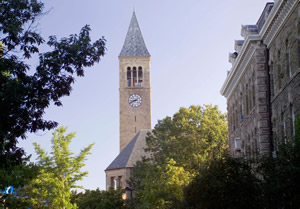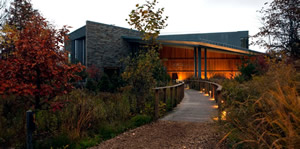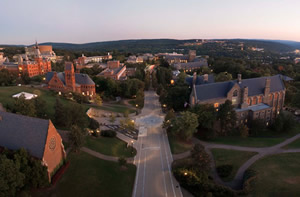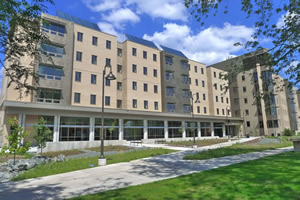Tipping the Scales

PHOTOS COURTESY OF CORNELL UNIVERSITY
We start each project with a wish list of green initiatives we want to accomplish, LEED levels we want to conquer and carbon footprints we want to shrink. Sure-footed in our environmental stewardship we stride forward, only to be hobbled by budget constraints, value engineering and the phrase “Return on Investment.” How do schools balance the desire for green with the need for an acceptable ROI? Three campuses tell their story… and the answers may surprise you.
Cornell University
This Ivy League school in Ithaca, NY, has lofty goals in place. According to their website: “As Cornell works towards becoming an increasingly green campus, each aspect of maintaining current facilities as well as planning for new construction is approached with sustainability in mind. This includes the siting of new buildings, their construction, building materials, maintenance and any other aspects that can be approached sustainably.”
 It continues, “The construction of recent buildings on campus and all plans for future construction and renovations will follow the United States Green Building Council’s Leadership in Environmental and Energy Design (LEED) rating system, furthering the University’s efforts to create a green campus for our students, faculty and staff as well as supporting the University’s commitment to the environment. In 2008 Cornell’s Board of Trustees voted that all building projects exceeding $5 million must achieve the Silver LEED Standard, as well as achieve 30 percent energy savings compared to ASHRAE’s 90.1 baseline, which is the national standard for energy efficient buildings.”
It continues, “The construction of recent buildings on campus and all plans for future construction and renovations will follow the United States Green Building Council’s Leadership in Environmental and Energy Design (LEED) rating system, furthering the University’s efforts to create a green campus for our students, faculty and staff as well as supporting the University’s commitment to the environment. In 2008 Cornell’s Board of Trustees voted that all building projects exceeding $5 million must achieve the Silver LEED Standard, as well as achieve 30 percent energy savings compared to ASHRAE’s 90.1 baseline, which is the national standard for energy efficient buildings.”
Cornell has been quite successful in reaching this goal while balancing the realities of ROI. Brad Newhouse, architect, project manager and leader of the Buildings Focus Team explains the give-and-take required. “With the renovation of old buildings it’s more important to obtain the right materials, like slate roofing or marble stair treads, than stay with the 500-mile distance [that LEED requires],” he says. “We will use regional materials where it is appropriate.”

BE CAREFUL WHERE YOU STEP. When Cornell University plans a new building’s site on its Ithaca, NY, campus, it is aware that orientation and post-construction site use can have strong environmental implications. The university aims to site buildings in ways that are mindful of the community’s transportation needs, water runoff, water usage, utilities, natural lighting and community character.
In a place like Cornell, where renovation and upgrades are de rigueur, facilities professionals call for interesting solutions. “We have taken on the challenge with one major facility (128,000 gross square feet) where we anticipate not using any more energy than what was used before when it did not have central air conditioning and other systems,” Newhouse reports. They accomplished this with “more energy-efficient lighting with occupancy sensors and four-pipe fan coil units also controlled by occupancy sensors so when the room is unoccupied it does not hold tight temperature control. We also included offices with windows to the exterior. The building will better serve the way people use a college building today.”
Newhouse admits that there are places where Cornell must compromise, like a dairy plant that had so many process loads that it was excluded from the LEED boundary. There are also times when LEED points or ROI were unobtainable but still made it into the project. “We included photovoltaic panels in the renovation for the Department of Natural Resources that may not pay back, but [it] is certainly a statement and a teaching tool. And it got us a LEED point,” he says. “On the same project we diverted half of the roof storm water into a rain garden. Not enough for LEED points, but the right thing to do.”
University of Wisconsin – Stevens Point, the Suites @201
Prior to undertaking this housing project, the University of Wisconsin–Stevens Point (UW–Stevens Point, UWSP) had 13 four-story residence halls with a total capacity of 3,100 beds. The Suites @201 is the first new residence hall on campus since the 1960s. With sustainability as one of the school’s core values, the goals for the Suites @201 remained lofty. According to the case study submitted to the Association for Advancement of Sustainability in Higher Education (AASHE), “The building would demonstrate the benefits of green design to the campus and community and serve as an environmental learning laboratory for students, staff and the community.”
From the beginning, the plan was to build the Suites @201 to the highest green building and performance measures, from a sustainable site development to materials selection and indoor environmental quality. Although Wisconsin’s Division of State Facilities has Sustainability Facility Standards that apply to all new and remodeled building projects, this project went beyond those state standards by pursuing LEED certification.
The economy helped tip the scales. “We were fortunate enough to build during a time in which the construction bidding climate was in our favor,” says Cindy Von Gnechten, Residential Living facilities designer, UW–Stevens Point. “Because of it we were able to incorporate environmental and architectural design elements that otherwise would have been cost-prohibitive to the project.”

PHOTO COURTESY OF THE UNIVERSITY OF WISCONSIN–STEVENS POINT
THE SUITE LIFE. From its beginning stages, the LEED Gold-certified Suites @201 on the campus of the University Wisconsin–Stevens Point were planned to be built to the highest green building and performance measures, from a sustainable site development to materials selection and indoor environmental quality.
Still, compromises had to be made. The project earned a Water Efficiency 1.2 credit with a non-irrigated site. Even though carefully selected specialty grasses and plantings were selected, the site’s aesthetics were compromised. “We frequently receive questions and sometimes even criticisms as to why the site condition is not as lush as its neighboring residence hall grounds and ballpark,” explains Von Gnechten.
Admittedly, the Suites @201 benefited from the slow economy. However, now that the construction market has tightened up UWSP remains committed to green building. “We are currently under construction with our third LEED-EB Silver renovation project, and have two more planned for 2014 and 2015… both of which are also slated to be minimally LEED-EB Silver-certified upon completion,” says Von Gnechten.
Valencia College
Much like the Suites @201 at UWSP, projects at Valencia College in Orlando, FL, benefited from the economic climate. In this case the largess came from swelling enrollment — and subsequent tuition dollars. “We really didn’t focus on ROI that much,” states Deborah Green, the school’s director of sustainability.
Instead, for the 66 buildings constructed between 1971 and 2012, the school emphasized energy efficiency. Having built six new buildings, and an entirely new campus, in the last four years, the school was lucky to work with some of the area’s best architects and engineers. And the maintenance staff knows, via trial and error, what works best for their unique surroundings.
In Florida’s case those surroundings are hot and humid. That means special emphasis was given to Valencia’s HVAC units. In the summer of 2012, three new 500-ton chillers were installed on the Osceola Campus. These magnetic-bearing, oil-free chillers lowered utility bills so much that more than $500,000 was returned to the college’s General Fund.
However, the new buildings also have energy recovery ventilation (ERV) systems, along with bipolar ionization. These technologies allow the building to use and re-use pre-cooled air without needing to re-introduce hot, humid outside air. Perfect for the Florida climate, bipolar ionization is not considered by the USGBC to allow adequate indoor air quality. Instead of LEED certification, Valencia’s buildings that use this energy-saving technology are built to the Green Building Initiative’s Green Globes standards.
“There is a fine line that a facilities department has to walk when building LEED Gold structures,” continues Green. “It may bring recognition and be good marketing, but in a college where the primary value is learning, we take a risk building to that level. Valencia has found that the biggest economic payoff has come from the energy savings.”
Although most U.S. states have renewable energy portfolio standards (RPS), Florida does not, and as such there are extremely limited rebates for onsite renewable energy. Still, that didn’t stop the school from installing a solar array on its University of Central Florida-Valencia College Joint Use Building. Even though it provides 16 percent of the building’s electricity, the ROI on the $875,000 technology is prohibitively long. “It’s sunny in Florida so we had to give it a try,” admits Green. “The building houses engineering classes so it provides teachable moments.”
Another place where there’s no focus on ROI is in the school’s building automation system. Over the years automated control contracts were awarded to the lowest bidder, resulting in seven different systems being in place throughout the institution’s different campuses. This allowed the staff to study and compare costs, performance and reliability of each system. The most efficient system won the sole contract.
With the economy improving, community colleges around the country aren’t seeing the massive influx of students, and Valencia is no exception. “We won’t be building any new campuses soon,” reports Green. “But when we do renovations we will remain focused on sustainability, especially on energy efficiency.”
This article originally appeared in the College Planning & Management August 2013 issue of Spaces4Learning.